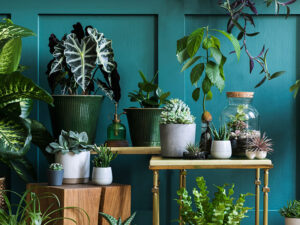The prayer plant, also known as Maranta leuconeura or M. bicolor, is a beautiful and popular houseplant with lots of personality. Although typically grown in pots or planters on the floor, this versatile plant can be trained up along a trellis, draped over an arbor or hung from hooks mounted on your wall.
Meet The Prayer Plant
The prayer plant belongs to the Marantaceae family, which is native to the Brazilian tropical forests. These plants are also considered epiphytes, which means that they grow on other surfaces and use their roots to collect water and nutrients from the air.
Because of their epiphytic nature, prayer plants can be grown in a variety of situations. However, they do prefer moist environments and should never be allowed to dry out completely or sit in standing water for more than a few hours. Prayer plant care is important because it not only ensures that the plant thrives but also that its roots don’t rot from being constantly wet!
Where did the name “prayer plant” come from?
The name “prayer plant” comes from their leaves, which lay flat during the day and then rise as the night approaches – thus giving the appearance of the plant praying. This behavior is an example of a diurnal rhythm.
Types of Prayer Plants
The Maranta genus contains about 40 to 50 different species. The most common type in cultivation is Maranta leuconeura, which features large green or yellow-green lanceolate leaves accented by red veins and flecks along its length. It prefers humid conditions like warm temperatures around 75°F (24°C), higher humidity levels between 60-80%, and indirect light.
It’s not uncommon for Calatheas to be labeled or referred to as prayer plants as well. Both plants belong to the same arrowroot family (Marantaceae) (and their leaves perform the same daily ritual). But only the Maranta plants are the true prayer plants.
Prayer Plant Care: The Basics
The prayer plant is a relatively drought-tolerant houseplant. It’s best to water it once per week and only when the top six inches of soil are dry – usually about every seven to ten days during winter, and less often in summer. Plants should be watered more frequently if growing outdoors or in humid environments.
A simple way to tell whether your plants need watering is by checking for moisture on the surface of their potting material. This will help prevent over-watering mistakes that can lead to rotting roots or leaves falling off due to excessive humidity indoors.
If you’re not confident that you can tell when your plant needs watering, I highly recommend picking up a few plant moisture sensors (I’m a big fan of Sustee Aquarmeters). Especially if you’re a new plant mom, these little tools will give you confidence that you’re not overloving (aka overwatering) your plant babies.
As a general rule of thumb with all plants, it’s better to underwater in comparison to overwatering – especially with prayer plants as they’re a delicate variety.

Prayer Plant Care: Quick Guide
Watering / Humidity / Light / Temperature
- Light Conditions: You’ll want bright indirect light for these plants. Place the plant in a sunny spot with protection from intense sun. Morning and evening light can be just as effective – as long as its indirect sunlight. Too much direct sunlight for hours on end, which will result in scorching or leaf loss.
- Water: Prayer plants grow best when they’re watered consistently but never allowed to dry out completely. They should never sit in standing water for more than a few hours at a time! They also don’t need frequent fertilizing; once every three weeks is sufficient if you want them healthier looking.
- Humidity: Depending on your type of prayer plant, it may need more or less humidity than other varieties. As a general rule of thumb, I mist mine every few days with distilled water to help increase their humidity levels. For my varieties that need a high humidity level, I have a small humidifier that I use as well.
- Temperature: Prayer plants can handle a wide range of temperatures (I recommend 68-85 during the day, and above 55 at night). Just make sure to protect them from freezing temps if you live in an area where that’s common!
Potting Soil / Fertilizing / Pruning
- Fertilizing: During the growing season, from early spring through fall, I recommend fertilizing every two weeks with all-purpose indoor plant food that is water-soluble (Miracle-Gro makes a great one that I personally use). During the winter, you can reduce this about once per month.
- Potting Soil: A prayer plant prefers natural to acidic soil. So I’d recommend going with a soil that has a pH balance between a 5.5 and a 6. If you’re looking to make the soil mixture yourself, create a mix that is two parts sphagnum peat moss, one part loamy soil, and one part perlite (or coarse sand). If you’re not interested in making your own mix, you can also use pre-packaged potting soil, just make sure it has good drainage.
- Repotting: Time to repot? Prayer plants need to be transplanted into a pot with new soil every year or two because their roots become crowded in the small pot.
- Pruning: In order to maintain size, you may want to prune your prayer plant back by about two-thirds in the winter months as they go into dormancy. It’s a key part of keeping the plant manageable, and it can also encourage growth if done regularly. If you have some yellow leaves on your plant, you can also remove these to help the overall appearance of your plant as well as reduce the risk of disease.
Pests & Other Things That Can Go Wrong
Pests
Prayer plants can sometimes be troubled by aphids or spider mites, but these are relatively easy to get rid of. I recommend using neem oil, as it’s natural and doesn’t leave a harmful residue. You can mix it with a dilution of soap and water to create a spray to use on your plant.
Another great way to combat pests (and especially gnats) is with a Katchy. I group my plants together in several areas of our house. And those areas are always prone to a little bit of activity being right at the window. I have four Katchys set up. I turn them on a night, and change out their sticky pads once a week. It made a huge impact on bug activity, and I’ve continued my night routine with them as a preventive measure.
Brown Edges
If your leaves start turning brown, this could be due to a number of issues. It could be low humidity, lack of water, or too much sun. Be sure to water regularly. And move further away from a window if you need to (so that the plant isn’t getting direct sunlight). Also, try to mist it regularly. (Or consider getting a little humidifier – I love this one for my prayer plants and my fiddle leaf fig).
Yellow Leaves
You may notice some yellowing leaves on your plant. If this happens, it’s likely due to being overwatered. Give the plant a break from watering for at least one week. And if that doesn’t help then you may need to replant it.
Propagation
The easiest way to propagate a prayer plant is by stem cutting (in the spring). You’ll want to cut your plant below the leaf node to propagate it. You’re looking for the spot where a leaf attaches to the main stem. After about two weeks, you should notice roots sprouting from one end or another.
Editor’s Note:
I first started my own plant collection with several calatheas and prayer plants. While I comically, and frequently, refer to these plants as my dramatic plant babies, they are among my favorite type of plants. The daily movement paired with the stunning designs of the leaves is the perfect mixture to mesmerize me.
It is challenging to keep their edges from browning. But if you’re reading this article, it shows you care. And you’re trying to do all you can for your plants. And at the end of the day, that’s all you can do! Best of luck with your prayer plant darlings, and stay tuned for more of our plant care guides!
Emily Sprinkle, also known as Emma Loggins, is a designer, marketer, blogger, and speaker. She is the Editor-In-Chief for Women's Business Daily where she pulls from her experience as the CEO and Director of Strategy for Excite Creative Studios, where she specializes in web development, UI/UX design, social media marketing, and overall strategy for her clients.
Emily has also written for CNN, Autotrader, The Guardian, and is also the Editor-In-Chief for the geek lifestyle site FanBolt.com
- Emma Loggins Sprinklehttps://www.womensbusinessdaily.com/author/emma-loggins/
- Emma Loggins Sprinklehttps://www.womensbusinessdaily.com/author/emma-loggins/
- Emma Loggins Sprinklehttps://www.womensbusinessdaily.com/author/emma-loggins/
- Emma Loggins Sprinklehttps://www.womensbusinessdaily.com/author/emma-loggins/







